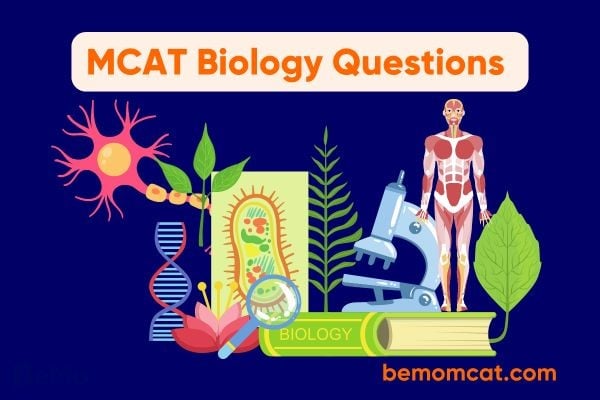Biology is the heart of medical science, so it's no surprise that MCAT Biology questions make up the majority of the MCAT subjects. This blog serves as an ultimate guide to understanding the Biology and Biochemical Foundations of Living Systems (BBFLS) section of the MCAT and how to approach MCAT biology questions. We’ll also take a look at several sample MCAT biology questions and expert breakdowns of the answers.
Disclaimer: MCAT is a registered trademark of AAMC. BeMo and AAMC do not endorse or affiliate with one another.
>>Want us to help you get accepted? Schedule a free initial consultation here <<
Listen to the blog!
What’s Tested on the MCAT Biology and Biochemistry Section
Most students are intimidated by the expansive volume of information involved in reviewing for the MCAT, and the BBFLS section most of all. This part of the test incorporates concepts taught at university during introductory-level biology and chemistry courses, as well as first-semester biochemistry courses.
The MCAT biology and biochemistry section covers the following foundational concepts:
Foundational Concept 1
- 55% of questions
- Biomolecules have unique properties that determine how they contribute to the structure and function of cells and how they participate in the processes necessary to maintain life.
Foundational Concept 2
- 20% of questions
- Highly-organized assemblies of molecules, cells, and organs interact to carry out the functions of living organisms
Foundational Concept 3
- 25% of questions
- Complex systems of tissues and organs sense the internal and external environments of multicellular organisms, and through integrated functioning, maintain a stable internal environment within an ever-changing external environment.
“Although biology is my favorite subject, the hardest part I found was making sense of the passages/experimental studies and their findings within the given time limit. I found the passages to be extremely dense at times but breaking it down into simple terms and focusing on the key results helped.” – Dr. Neel Mistry, MD
For a detailed MCAT biology guide and list of subtopics included within these three foundational concepts, check out the AAMC’s guide to what’s on the MCAT exam, and specifically the BBFLS section. Here’s an overview of the main subtopics included in this section of the MCAT:
Sample MCAT Biology and Biochemistry Questions
MCAT biology practice passages and questions are a great way to start testing your knowledge of MCAT subjects:
MCAT Biology Passage
The myocellular transmembrane Na+ gradient is important for proper cellular function. During septic shock, disruption of Na+ homeostasis often occurs and leads to decreased membrane potential and increased intracellular Na+. It has been found that failure of cellular energy metabolism is a common symptom in septic patients who do not respond to therapeutics. Because normal intracellular levels of Na+ are maintained by the Na+K+ ATPase, it is important to understand how metabolic energy production is linked to cation transport.
Researchers are interested in whether the energy used for ion transport is derived from glycolysis or oxidative phosphorylation. This information would provide a better understanding of myocellular damage that occurs during critical illness. Experiments were conducted to evaluate the effects of glycolytic inhibition on cellular Na+ and K+ concentrations and lactate production in rat skeletal myocytes.
Rat skeletal muscle fibers were extracted and incubated in normal media (control), glucose-free media (G(–)), and glucose-free media with various concentrations of the glycolytic inhibitor iodoacetate (IAA). IAA directly prevents the formation of 1,3-bisphosphoglycerate. After one hour in the media, the muscle tissues were assayed for intracellular Na+ and K+ content and lactate production. Cellular viability was determined by measuring the amount of lactate dehydrogenase (LDH) released, as LDH release is an indicator of cell death.
The results are displayed in Figure 1:
Figure 1: Effects of glycolytic inhibition on intracellular Na+ and K+ content and lactate production with cellular viability measured by LDH release. (Note: The * indicates p < 0.05 versus control.)
The researchers also examined the effect disruption of oxidative phosphorylation had on Na+ and K+ content. Inhibition of oxidative phosphorylation was caused by carbonyl-cyanide m-chlorophenylhydrazone (CCCP), an ionophore that allows protons to move freely through membranes. No correlation between Na+ and K+ content and oxidative phosphorylation was found.
Adapted from: Okamoto K, Wang W, Rounds J, Chambers EA, Jacobs DO. ATP from glycolysis is required for normal sodium homeostasis in resting fast-twitch rodent skeletal muscle. The American Journal of Physiology-Endocrinology and Metabolism. 2001 Sept;281(3):E479-88.
Sample MCAT Biology Questions and Answers
1. The researchers chose a concentration of 0.3 mM IAA as the working concentration for any additional studies instead of 1 mM or 2 mM. What is the likely reason for this?
A) The lower concentration of IAA gave the largest Na+ response.
B) Higher concentrations induced significant cytotoxicity.
C) The solubility of IAA was not high enough.
D) The researchers were trying to mimic control conditions as closely as possible.
2. The information in the passage suggests that glycolysis:
A) is important for maintaining normal Na+ and K+ levels in skeletal muscle.
B) facilitates membrane permeability in skeletal muscle.
C) impedes the function of the Na+ and K+ ATPase in skeletal muscle.
D) is regulated by the Na+ and K+ ATPase in skeletal muscle.
3. If the effects of IAA treatment in nerve cells are the same as those observed in myocytes, which feature of an action potential would be most affected by IAA treatment?
A) Initiation of depolarization
B) Rising phase of depolarization
C) Falling phase to undershoot
D) Return to resting potential
4. How is the basal layer of the epidermis and the innermost lining of the small intestine similar?
A) Both are non-dividing tissues.
B) Both are derived from ectoderm.
C) Both are composed of squamous cells.
D) The cells of both are connected by tight junctions.
5. Starting with the translation initiation codon, the following sequence encodes a polypeptide of how many amino acids?
5'-CUGCCAAUGUGCUAAUCGCGGGGG-3'
A) 2
B) 3
C) 6
D) 8
6. Sodium dodecyl sulfate (SDS) contains a 12-carbon tail attached to a sulfate group and is used in denaturing gel electrophoresis of proteins. Numerous SDS molecules will bind to the exposed hydrophobic regions of denatured proteins. The use of SDS in this experiment allows for the separation of proteins by:
A) charge
B) molecular weight
C) shape
D) solubility
7. In the figure, the three curves represent hemoglobin oxygen binding at three different pH values, pH 7.2, pH 7.4, and pH 7.6.
What conclusion can be drawn from these data about the oxygen binding of hemoglobin at different pH values?
A) Low pH favors the high affinity oxygen binding state.
B) Low pH favors the low affinity oxygen binding state.
C) Oxygen affinity is independent of pH.
D) Oxygen binding is non-cooperative at low pH.
Check your answers below!
Click through to read the correct answers!
Want more MCAT study tips? Watch this video:
Tips for the MCAT Biology Section
Tip #1: Use Active Learning Techniques
Active learning techniques will allow you to absorb, learn and retain the huge amount of information covered in this section more effectively. Use the study methods that work best for you, whether this is using flashcards, mnemonics or other visual learning techniques. Visual learning also helps you with your information recall.
“Writing out any sort of process insteps, anything kinesthetic helped more with [MCAT Biology] … Utilize active learning in content review, draw things out, create mnemonics, and adjust your study tools to match the material so you can learn it more effectively and efficiently. If you are studying glycolysis–a flowchart helps more than putting this entire concept on a flashcard. If looking at differences between insulin and glucagon–a Venn diagram works better than a flowchart. Amino acids can be grouped by properties using mnemonics, but could also be drawn and put in a table.” – Dr. Noah Heichel, DO
Tip #2: Review Course Content
The MCAT biology section covers a large number of topics and concepts you’ll learn in your introductory biology courses during undergrad. Hold onto those course notes, textbooks and any study materials. You can use them during your MCAT prep. Many students also take the MCAT in their junior year of undergraduate so the concepts covered on the exam are fresh in their minds.
“I had just taken biochemistry in the spring semester preceding my MCAT and had also concurrently taken general biology in the fall, so these were my strongest science sections … I focused on refining my strongest points, reviewing topics I had grasped previously, and focusing on high yield for the items I didn’t know.” – Dr. Monica Taneja, MD
Tip #3: Practice Applying Your Knowledge
Textbook and course notes review is only half the strategy you need to ace this section. Apply your learning with regular practice tests. This will help you understand whether your content review is working and you’re truly learning the concepts tested on the MCAT.
“I made a conscious effort to relate biology and chemistry concepts to real-life applications and examples. This not only enhanced my understanding but also kept me motivated to learn. I also incorporated variety into my study sessions by alternating between learning materials and practicing questions. This approach helped me stay focused and made the study process more enjoyable.” – Dr. Cathleen Kuo, MD
1. What if I encounter a very difficult passage within the biology and biochemistry section of the MCAT?
Try not to panic! Start by reading the passage to obtain a general understanding. Go through the passage one paragraph at a time, pausing after each paragraph to ask yourself what the paragraph was about. At the end of the passage, link these ideas together into an overall understanding. Ask yourself what the central thesis of the passage was.
2. What is a good score on the biology and biochemistry section of the MCAT?
The biology and biochemistry section of the MCAT is scored on a scale of 118-132, with the median score set at 125.
3. I am only having trouble with the biology and biochemistry section of the MCAT and I am doing well on the other sections. Does that matter?
Each medical school interprets your MCAT scores differently and some may even put an emphasis on particular sections. In general, most medical schools will view balanced scores more favorably than imbalanced scores. This consistency will show your ability to think critically in many different content areas, a skill that medical schools value.
4. How can I strengthen my skills in reading and interpreting graphs and figures within passages?
Getting involved in a research lab is a great way to strengthen your skills in reading and interpreting graphs for experiment-based passages. You can also learn how to read MCAT graphs and practice with MCAT prep questions.
5. Is there specific coursework that I should take to prepare for the biology concepts on the MCAT?
While introductory biology courses include the topics on the MCAT, they may not cover them in great detail. By taking more advanced biology courses, you will increase your depth of understanding, which will give you an advantage on tougher MCAT questions.
6. How can I minimize test day stress?
Resist the temptation to spend the day before the exam trying to review all of your notes or cramming last-minute information into your head: this is not an effective strategy to improve your MCAT score! Make sure you prepare everything for test day the night before. On test day, be sure to take the optional breaks to give yourself some time to decompress.
7. What biology subjects are on the MCAT?
The biology content on the MCAT spans a wide variety of topics from molecular biology, cell biology, microbiology, and genetics, to the physiology of organ systems.
To your success,
Your friends at BeMo

